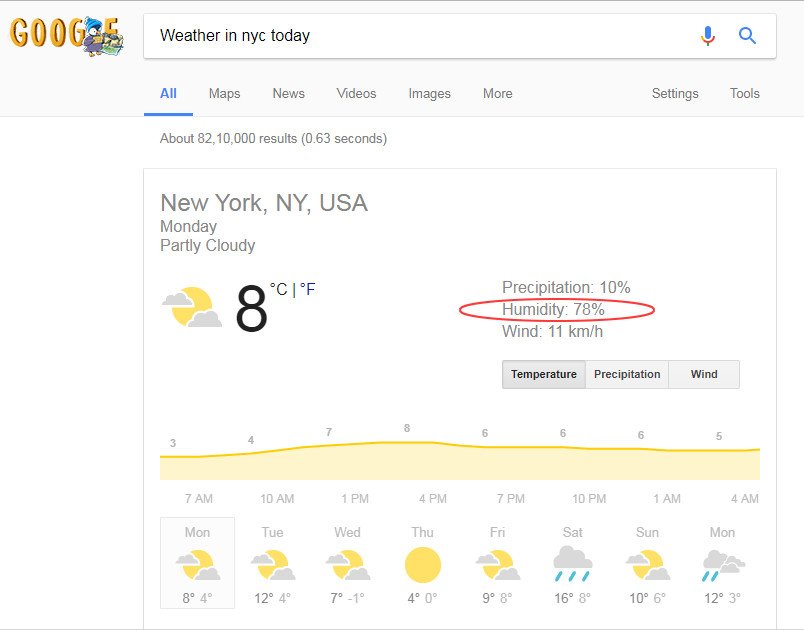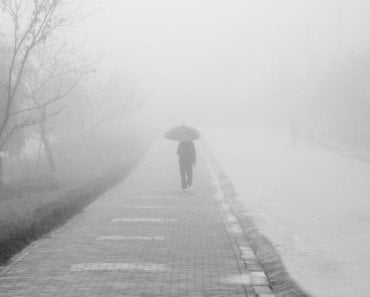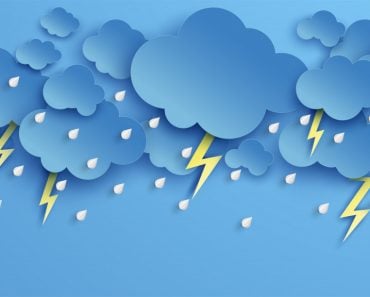Table of Contents (click to expand)
Too tired to read? Listen on Spotify:
100% humidity means that the air is holding the most amount of water it can possibly hold at the given temperature.
A few days ago, a child told me he had been closely following weather reports on news channels. In the process, he discovered that he was particularly interested in the concept of ‘humidity.’ He mentioned that he had seen the term ‘air humidity’ used repeatedly in weather reports and on search engines whenever he checked the temperature of his city.
On reflection, it is interesting to consider why weather reports include numerous mentions of ‘air humidity’ or just ‘humidity,’ which is usually expressed in percentages.
For example, you can see this in the following screenshot:

It shows the humidity in New York City to be 78%, but what exactly does that mean?
If you have ever paid attention, you might have noticed that the humidity values are sometimes even 100%. What’s that all about? Does that mean the air has become water, and people are breathing… water?
Recommended Video for you:
What Is Humidity?
Humidity, in simple words, measures how ‘wet’ the air is in a given place. More specifically, humidity is the amount of water vapor present in the air. Water vapor, as you well know, is the gaseous state of water and is, therefore, not visible to the naked eye.

You might have heard people say that it’s not just the heat; it’s the humidity that makes them uncomfortable. This is because hot temperatures can feel even more unpleasant when more water vapor is in the air.
Note that humidity is a broad term that refers to three types: absolute, relative, and specific humidity.
Weather forecasters frequently use the terms absolute humidity and relative humidity when reporting weather conditions.
Types Of Humidity
Absolute humidity is the measure of the total mass of water vapor in a given volume of air. Mathematically, absolute humidity can be calculated by dividing the volume of the air and water vapor mixture.

However, the calculation of absolute humidity does not consider the system’s temperature; the former’s value is affected by changes in the air temperature or pressure changes.
Specific humidity, on the other hand, is the ratio of the mass of water vapor to the total mass of the moist air parcel. It’s often casually referred to as the ‘moisture content’.
That being said, the type of humidity that is most relevant to our discussion is relative humidity.
Relative Humidity
Relative humidity refers to the amount of water vapor in the air compared to what the air can hold. It is expressed in percentages and can be seen in weather reports. For example, a relative humidity of 78% means that the air holds 78% of what it can actually hold for the given temperature.
Think of it this way: if you have a half-full glass of water (i.e., at 50%), you would say that the glass contains 50% of what it can hold. The concept of relative humidity is pretty similar.

“100% Relative Humidity”
Relative humidity is a measure of how saturated the air is with water (as air can only carry so much moisture at a given temperature).
If the weather report shows the relative humidity value to be 100%, it doesn’t mean that air has become water; rather, it means that any additional moisture cannot enter the air and must remain as water. Fog is a good way to imagine what 100% relative humidity looks like.

When the air holds the maximum amount of water possible at a given temperature, it is said to have 100% relative humidity. This does not mean the air has turned into water; just like a sponge fully saturated with water, it doesn’t become water itself. Similarly, a relative humidity of 100% doesn’t mean that the air has turned into water, so leave your scuba gear at home!
Last Updated By: Ashish Tiwari
References (click to expand)
- Relative Humidity: indicates how moist the air is.
- Green, J., & Dyer, I. (2009, January). Measurement of humidity. Anaesthesia & Intensive Care Medicine. Elsevier BV.
- Nguyen, J. L., Schwartz, J., & Dockery, D. W. (2013, June 18). The relationship between indoor and outdoor temperature, apparent temperature, relative humidity, and absolute humidity. Indoor Air. Hindawi Limited.













